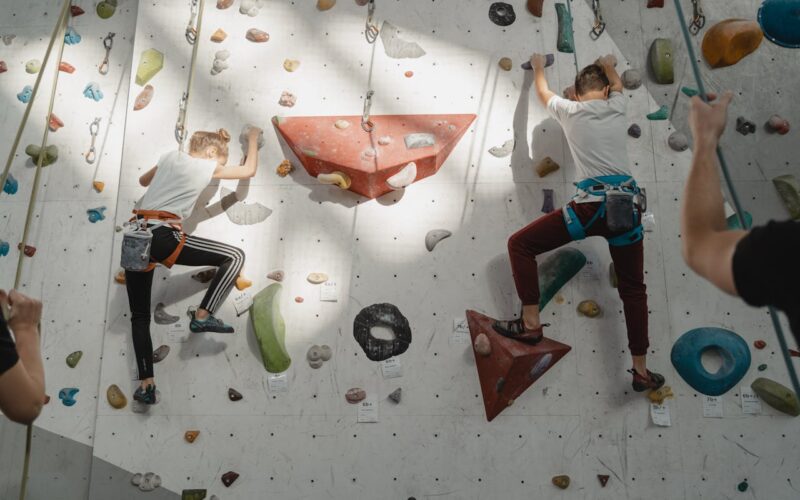Climbing has grown significantly in popularity in recent years. The sport gained widespread attention in 2020 when it debuted as an Olympic discipline in Tokyo, and again in 2024, when bouldering (climbing to a maximum height of 4.5 metres without a rope) was included in the Paris Olympic Games. Over the last decade, it has increasingly been used as a therapeutic medium, not only in physiotherapy but also in psychotherapy. In addition to qualities it shares with other physical and creative media used in therapeutic settings, climbing has characteristics that make it a particularly helpful tool—such as fostering stress reduction in everyday life.
3 Qualities Climbing Shares with Other Activities Often Used as Therapeutic Media
In therapeutic contexts, various activities are combined with cognitive therapeutic methods—such as working with horses, dance, or the creative arts. What aspects does climbing have in common with these methods in supporting the therapeutic process?
1. Direct connection between experience and reflection: Sensations and emotions may arise during physical or creative activities. Often, the experiences clients discuss in sessions are made during those same sessions. This allows for a direct link between what is experienced and how it affects the individual.
2. Opportunities to test alternative behaviours immediately: During reflection with the therapist, new ways of coping with challenging situations may be discussed. When activities are integrated into therapy, these ideas can be tested and internalised right away.
3. Activities as a motivation to engage further: People who are not naturally inclined to talk through their challenges benefit from the opportunity to process them through direct experience. This can enhance enjoyment during sessions and increase client motivation to engage in the therapeutic process.
5 Qualities That Make Climbing a Particularly Suitable Tool for Therapy
Beyond what it shares with other therapeutic media, climbing offers specific features that make it especially beneficial for therapy.
1. Creating emotionally intense scenarios within a safe setting: Despite its reputation, climbing is a safe activity when practiced correctly. Studies and accident statistics show that the injury risk in indoor rope climbing is relatively low when safety equipment is used properly. Most accidents in climbing gyms result from ground falls due to equipment misuse or uncontrolled falls. Using modern safety equipment creates a physically safe environment for what feels like a risky experience.
2. The (somewhat) helpful narrative of heroism: While courage should never be defined by physical performance in therapy, society’s perspective on climbing as something heroic can help foster self-worth and empowerment when clients succeed on the wall.
3. Reciprocal trust between therapist and client: Many sports can explore themes of trust, but in climbing, responsibility for the partner’s safety becomes physically real—not just metaphorical. This dynamic makes discussions of trust especially poignant and tangible.
4. Climbing as a metaphor for everyday life: Climbing terminology often has symbolic resonance. Memorable metaphors—such as “making it to the top,” “getting a grip,” or “letting go” (just to name a few)—can help clients remember and apply successful strategies for coping with everyday emotional challenges.
5. Easily adjustable challenge levels: Climbing offers therapists a wide range of options for adjusting the level of physical and psychological challenge. Routes are rated by difficulty, allowing tailored experiences. By selecting the height or complexity of a route, therapists can fine-tune the challenge to the client’s needs. These adjustable parameters support the therapeutic process by enabling success experiences and carefully graded exposure, helping clients become aware of their reactions—such as fear or stress—without being overwhelmed or under-challenged.
How Does Therapeutic Climbing Promote Stress Management?
We often perceive stress as something unpleasant that we prefer to avoid. Negative stress arises when our brain classifies a situation as uncontrollable and thus activates a type of chronic stress. Stress originally has a very positive function, however. When our brain classifies the situation as controllable, stress triggers stabilizing effects in the nervous system, and we develop stress resilience in overcoming situations that we perceive as threatening.
The climbing wall offers a protected setting for clients to cope well with their own stress. On the one hand, climbing challenges them to go out of their comfort zone – which is necessary to train the body and mind to face stressors and fears with greater courage. With experienced therapeutic support, the client thus enters the so-called zone of proximal development – an area that the client perceives as challenging but manageable. In this case, the sense of achievement when subjectively difficult moves are accomplished regularly on the climbing wall leads to stress reduction in the long run: By regularly overcoming challenges in a controlled manner on the climbing wall, the brain develops new skills for dealing with frightening and stressful situations.
Climbing as a Pathway to Therapeutic Growth
Climbing provides a structured, metaphor-rich environment that can enhance therapeutic outcomes in meaningful ways. Its unique combination of emotional intensity, adjustable challenge, and opportunities for trust-building positions makes it a valuable medium in therapeutic settings. As an activity that naturally evokes themes of perseverance, risk-taking, and personal achievement, climbing enables clients to engage with therapeutic goals in a deeply embodied and experiential manner. As the integration of physical and mental health practices continues to evolve, climbing holds a promising place among the modalities supporting holistic well-being.
Sources:
Kowald, A. & Zajetz, A (2015). Therapeutisches Klettern. Anwendungsfelder in Psychotherapie und Pädagogik. Stuttgart: Schattauer.
Paffrath, Hartmut (2017): Einführung in die Erlebnispädagogik. (2. überarb. Aufl.) Augsburg: ZIEL – Zentrum für interdisziplinäres erfahrungsorientiertes Lernen GmbH
Schöffl, V., et al. (2013). Injury trends in rock climbers: Evaluation of a national registry over 10 years. Reference: Wilderness & Environmental Medicine, 24(2), 107–113.
